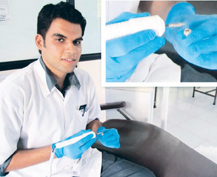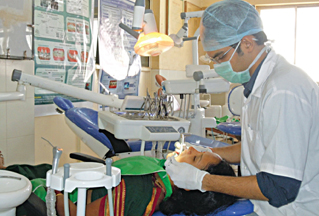
APRIL 2012: It is not every day that you come across dentists who can also innovate. Sameer D. Jain, a student in Nashik pursuing his degree in BDS, has invented a low-cost root-canal obturating prototype. The device addresses issues with an ordinary obturating device by using a unique combination of sonic vibrations and heat.
Jain, who has no background in electronics, created the device with help from a local electrician. He claims that the device is failure-proof as it meets all the challenges a dental operator comes across when conducting a root canal obturation. It took him only two to three months to create the device, and another two months to test it on an extracted tooth and study its efficacy in comparison to other techniques.
Obturation process: what it lacked
Obturation is the process of filling the tooth with a thin, rubbery material called Gutta percha and coating with a sealing agent in a root canal treatment. Conventional obturating machines place Gutta percha into the canal and compress it tightly.
“The drawback of this technique is its inability to achieve a three-dimensional homogenous apical seal. There are chances of air gaps and voids being present in case of curved canals, since Gutta percha is mechanically compact and incapable of flowing in to achieve sealing. This cold lateral compaction technique is far less reliable in preventing re-infection,” Jain shares. Apart from the risk of re-infection, Jain says, the cost of equipment is also a major drawback—a reason why these equipment are not common in India.
Jain took these limitations into consideration and designed a low-cost obturating prototype called Magik. Jain asserts, “Other systems available in the market either have only heat or ultrasonic vibration applications. It is the unique combination of thermal property and sonic vibrations that differentiates this prototype from the already available devices. This combination helps the device in removing the pulp as well in obturation.”
A patent application has already been filed with the government of India, Intellectual Property Office (IPO), for the complete internal hardware and design of this machine.
Magik in action

Magik is custom-designed using a sonic micro-cylindrical vibrator motor, a transistor, copper tips and a foot control. The main control unit has a micro-filter circuit, which is responsible for smooth running of the machine. It operates off 110-130V and 220-240V, with heating power of 8W.
Gutta percha has to be transformed to its alpha phase, i.e., a molten phase, for a root canal treatment. On heat application of 60-70ºC, Gutta percha changes its structural properties and flows well. The vibratory strokes enable Gutta percha to adhere better to the canal walls and achieve better sealing. Thus by using the heat and sonic vibratory root canal obturating device, a 3-dimensional, homogenous, fluid-tight seal is achieved.
Sonic chosen over ultrasonic vibrations
Sonic vibrations have low frequency (4000 Hz to 12,000 Hz), covering a high amplitude per oval turn. Ultrasonic vibrations of 30,000 Hz to 40,000 Hz, on the other hand, have lower amplitude and increase the device cost by Rs 15,000-20,000.
“The only drawback of using sonic vibrations is it that its frequency is less but it can be compensated with time. The difference is a matter of a few seconds,” reveals Jain.
It produces a larger distribution around the tip and the mode of vibration is less affected by wall-contact than when ultrasonic devices are used. Hence sonic vibrations allow formation of a homogenous mass devoid of any air space. Vibratory strokes enable Gutta percha to flow into lateral canals, achieving better lateral canal seal.
The cost factor
Jain discloses that cost was always a concern as his parents funded the project. He adds, “I could not think of being lavish and tried to keep the costs as low as possible without compromising on efficiency. Hence I went ahead with the use of sonic vibration, which by itself makes the product economical.”
Jain created about seven prototypes before he came up with the final version. Creating the prototypes cost between Rs 2000 and Rs 3000. It was still much better than similar machines which cost Rs 100,000-125,000. Jain decided to use sonic vibrations to help Gutta percha flow in lateral canals, i.e., the horizontal plane.
“Sonic vibration is a cheaper alternative to ultrasonic. Moreover, recent studies have shown it to be more efficient,” Jain explains.







